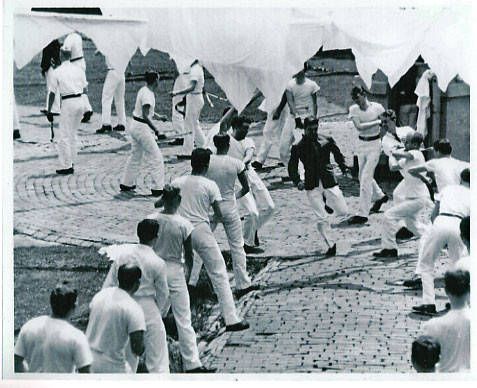In Barry Lyndon and other movies, like the Russian remake of The Duelist, you see European officers being forced to run a gauntlet for punishment. This is so similar to the American Indian practice, I was wondering if there was a connection. Is this a universal thing, or did one group borrow it from the other?”
Mister Grey
Thanks for the good question, sir. Below is an entry from a phrase origin site:
“It would be natural to assume that gauntlets were used in the beatings and that ‘running the gauntlet’ derived from that. In fact, that’s not the case and neither the punishment nor the phrase have anything to do with gauntlets, either military or horticultural.”
“The name of the brutal punishment was originally ‘running the gantelope’. Gantlope is an Anglicized form of the Swedish word ‘gatlop’, or ‘gatu-lop’, which refers to the gate of soldiers that the victim had to pass through. The Ist Earl of Shaftsbury recorded the phrase in his Diary, 1646:
‘Three were condemned to die, two to run the gantelope.’
“It didn’t take long for gantlope to migrate into ganlet, or gauntlet – possibly as a result of a simple muddle over the similar-sounding words…”
In my Plantation America research and avid reading on American Indian and European military cultures my entire life, I have discovered the following facts concerning Running the Gauntlet.
- Military beatings by superiors and peers have the following trajectory through the Aryan martial experience:
- Boxing as a means of symmetrical seasoning for the warrior came about 4,000 BP.
- The practice of judges beating rules breakers during sacred prize-fights dates back 2,700 BP.
- The beating of soldiers by officers and the execution of soldiers by their squad-members, dates back to about 2,200 BP.
These traditions fell into disuse in feudal society from the Dark Ages through the High Middle Ages and were consciously resurrected in European militaries in the late 1500s and early 1600s, even as the ancient Roman ideal of slavery was elevated to an innovative economic model.
The first mightily cruel national military was the Swedish army of Gustovus Adulphus, whose men made Germans drink sewage and were all but unbeatable in the Thirty Years War, from 1618-48. Among Swedish martial reforms a version of the habits of decimation and rod punishment among the Roman military was adopted as a means of discipline.
According to Cotton and Increase Mather in their Wonders of the Invisible World, suspected witches were being made to run the gauntlet in Sweden before any such tradition was common among Indians.
The only Indians using this practice were Iroquois and Algonquin tribes closely tied by marriage, adoption, alliance, slave-catching and gun-running with the English, Dutch and Swedes of North America.
According to disease impacts in Central and South America from European contact in the 1500s, and taking into account the fact that European sailors were in regular contact with coastal tribes, and the fact that these tribes experienced a 40% population reduction instead of the 90-100% reduction in other regions, and that all accounts of aborigine-explorer contact involve sailors trying to runaway and live with the primitives, one can imagine these much-beaten men introducing the corporal punishment they suffered as hazing as a tribal induction once they were established as tribal members. The first action of Captain John Smith on meeting Powhotan was to give or trade his personal slave [an English boy] to the bearded chief, who raised him as a son. Keeping in mind that some tribes like the Susquehannock, Delaware, Doegs, Westos and Stockbridge Indians seemed to be racially European and did not even come into existence until after European contact, with the Susquehannock population doubling every 20 years after first contact, it is obvious that many of these warriors, were or had fathers that were previously sailors, who were classed either as military or paramilitary personnel depending on the nation and time. Of the 100 men who Drake and Hawkings set off at the mouth of the Rio Grande to walk to cape Briton Canada, only three made the entire trek, with the rest electing to stay with their Indian hosts, who greeted them all along the way as allies, in the wake of Soto Invasion 20 years earlier.
In short, the running of the gauntlet was a form of military and religious hazing and punishment in Europe, and among Indians of European ancestry in North America, became a means of induction from European society into Indian society. Any Eastern Woodlands tribe conducting gauntlet runs can rightly be regarded as being more than 50% European by ancestry and essentially operating as hybrid heathen communities, often living in cabins and long houses like Europeans at “First Contact” and even having mythological elements such as the regard for a masculine Thunder deity among longhouse dwellers, two obvious elements shared with Europeans.
Like many aspects of Plantation America, when preserved in the “snapshot” habit of American Academia, what we perceive as an origin and end stage in one glance, turns out to be the last vestige of something ancient and far more complex than the American Mind can, according to its abject conditioning, contain.

James is a full-time writer, part-time coach and part-time wage slave with an extensive history of brain trauma. Check out: http://www.jameslafond.com/



